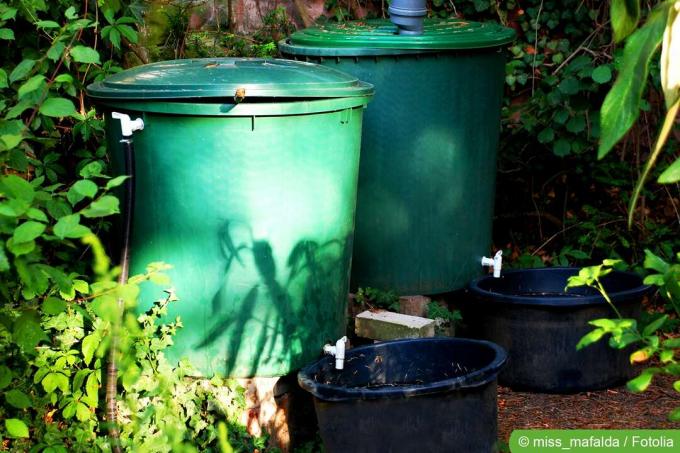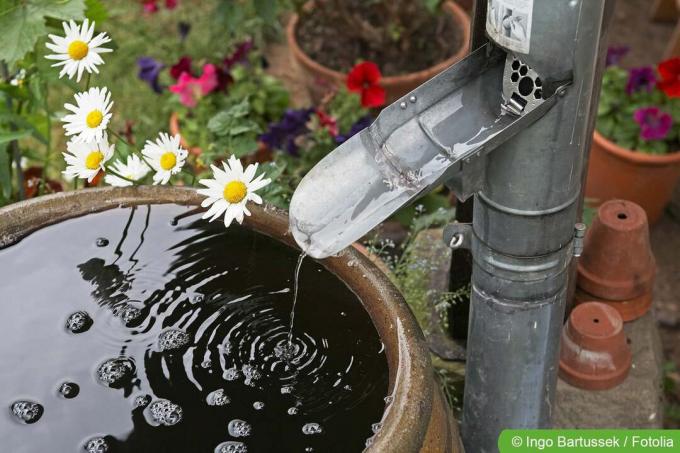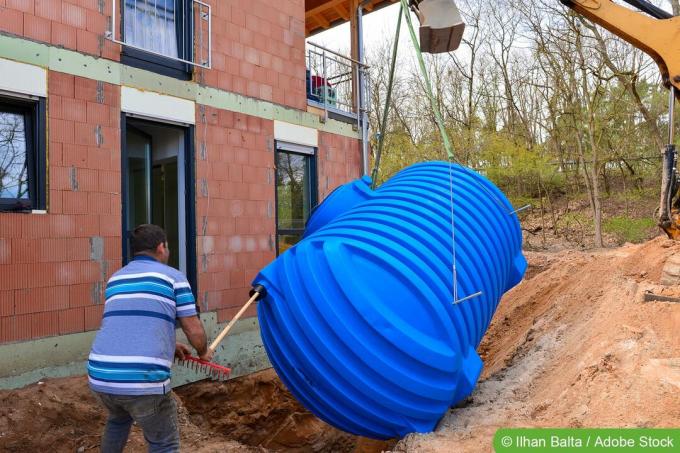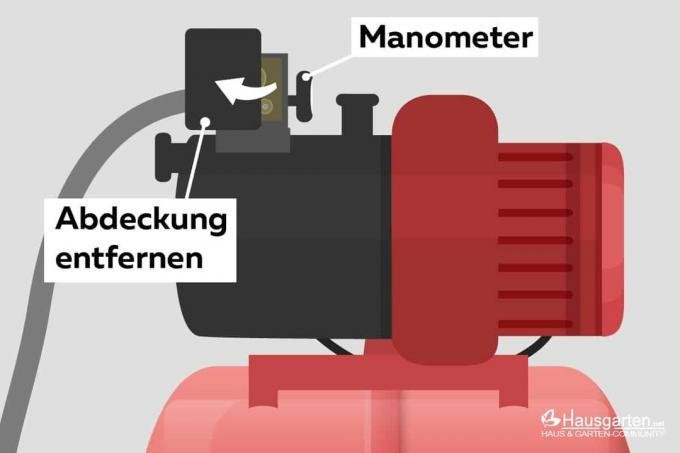

Table of contents
- Classic plastic rain barrel
- Advantages:
- Disadvantages:
- wooden barrels
- Advantages:
- Disadvantages:
- wall tank
- Advantages:
- Disadvantages:
- rain columns
- Advantages:
- Disadvantages:
- rainwater amphorae
- Advantages:
- Disadvantages:
- rainwater cisterns
- Advantages:
- Disadvantages:
- infiltration systems
- Advantages:
- Disadvantages:
- frequently asked Questions
Collecting rainwater saves money and water resources and offers an ideal, low-lime irrigation option in the garden. There are a number of ways to collect rainwater, each with their own advantages and disadvantages.
Classic plastic rain barrel
The best-known and simplest method for catching and collecting rainwater is the classic rain barrel. It is simply placed under the gutters or downpipes and provided with a lid so that the rainwater does not get dirty.
Costs: depending on the capacity between 20 and 180 euros
Collecting amount: between 30 and 500 liters

Advantages:
- can be ideally adapted in size to the available space
- quick and easy to set up
- mobile and changeable
- can be provided with water tap and pump
- Above-ground attachment and therefore always the water level in view
- Overflow protection available with an overflow valve
Disadvantages:
- visually not an eye-catcher
- must be cleaned two to three times a year to avoid cyanobacteria
- winter only three quarters full
- are exposed to the weather, which shortens the lifespan of plastic water butts
- popular breeding ground for mosquitoes
- should not be used on copper, zinc or tar paper roofs due to possible metal compounds and/or biocides
- not suitable for domestic water supply
wooden barrels
Especially for collecting rainwater, wooden barrels are a more decorative alternative to the classic plastic rain barrel. They meet similar requirements, but can be tastefully integrated into gardens due to their natural wood look.
Costs: between 160 and 450 euros
Collecting amount: between 180 and 500 liters

Advantages:
- emphasizes natural flair in the garden
- more robust and durable than plastic water butts (7 to 10 years average lifespan)
- quick and easy to set up
- mobile usable
- can be provided with water tap and pump
- Above-ground attachment and therefore always the water level in view
- Overflow protection available with an overflow valve
Disadvantages:
- more expensive to buy than plastic rain barrels
- Only three quarters full in winter
- Wood requires regular care due to weather influences
- popular breeding ground for mosquitoes
- should not be used on copper, zinc or tar paper roofs due to possible metal compounds and/or biocides
- not suitable for domestic water supply
wall tank
The wall tank offers the most space-saving option for catching and collecting rainwater. It is mounted on a wall or facade near the gutter/downpipe and is characterized by its narrow depth and a stylish design with a wood or stone look.
Costs: depending on the size between 100 and 1,000 euros
catchment capacity: between 250 and 1,400 liters
Advantages:
- not recognizable as a rainwater collection tank
- can be set up to save space
- provided with water drain valve or tap
- Garden hose connectable
- decorative lid
- can also be used as a shelf
- different designs and shapes available
- mostly made of high-quality high-density polyethylene, therefore very light and weather-resistant
- easy to change
Disadvantages:
- more expensive than simple plastic water butts with the same capacity
- must be cleaned two to three times a year to avoid cyanobacteria
- Only three quarters full in winter
- should not be used on copper, zinc or tar paper roofs due to possible metal compounds and/or biocides
- conditionally suitable for domestic water supply
rain columns
This type of rainwater catchment and collection container is still fairly new on the market and is a further development of the conventional water butt. Also known as a column tank, it differs from this in that it is smaller in size, among other things.
Costs: depending on the volume and capacity between 160 and 800 euros
catchment capacity: between 300 and 2,000 liters
Advantages:
- takes up less floor space with the same or larger filling volume
- more filling capacity than conventional water butts
- visually unobtrusive
- quick, easy assembly
- significantly cheaper than cisterns
- Natural water pressure due to the column shape, which makes a pump superfluous
Disadvantages:
- is visually reminiscent of simple gas tanks with no appealing decorative value
- Water drain usually not included
- significantly more expensive than conventional rain barrels
rainwater amphorae
A real highlight is to put rainwater amphorae in the garden as well as on terraces and balconies. They look like large, ancient Roman, pot-bellied vases and exude a Mediterranean charm because they are made of clay/terracotta.
Costs: between 90 and 600 euros
catchment capacity: 240 to 600 liters

Advantages:
- particularly UV-stable and weather-resistant
- unobtrusive rainwater collection
- high decorative value through stylish, Mediterranean design
- planting possible
- Less space required due to smaller floor area than with conventional water butts and wooden barrels
- with water drain
- most of time garden hose connectable
- Terracotta as an environmentally friendly and sustainable raw material
- natural water filtration and consequent reduction of water disinfection chemicals
- Water level measurement possible
- frost resistant
Disadvantages:
- regular cleaning required
- Difficult to clean due to shape
- smaller capacity than other rainwater tanks
Tip:
If you don't like the look of rainwater amphorae, you will find a comparable way to collect rainwater in the 2-in-1 design bins. These are constructed in a similar way to normal plant pots and, like the amphorae, consist of a combination of "rain barrel" and plant pot.
rainwater cisterns
For the almost invisible and larger collection of rainwater A cistern placed in the ground is a good idea. The rainwater is channeled into the cistern over larger roof areas and can be used in a variety of ways.
Costs: depending on the size and condition between 1,000 and 6,000 euros plus installation, connection and water pump
Collecting amount: up to 100,000 liters

Advantages:
- with domestic waterworks also usable for toilets, washing machine, dishwasher and bathing
- Connection of lawn sprinklers, garden hoses and other irrigation systems possible
- connection with water tap for normal water withdrawal
- Resizing to personal needs on an extended family (provided it rains enough)
- high savings on water costs
- no building permit for loosely inserted plastic cistern
Disadvantages:
- Depending on the size and structural scope, higher investment costs than for a rain barrel
- Investments sometimes only pay off after years
- Cost savings depending on the amount of rain
- If the amount of precipitation is too low, a switchover to the municipal fresh water supply is required
- only suitable for garden owners

Tip:
Although cisterns do not require a permit to be installed throughout Germany, most federal states have a maximum size of 50 cubic meters. If the size is exceeded, a permit must be obtained.
infiltration systems
The infiltration systems are particularly suitable in regions with high rainfall. They consist of special shafts and/or drainage pipes, in which the rainwater runs underground is taken up to slowly release it to the earth and in this way for an automatic provide irrigation system.
Costs: between 5 and 45 euros per square meter plus costs for floor work where applicable; professional trench infiltration up to 5,000 euros total costs
catchment capacity: depending on rainfall, soil density and system size
Advantages:
- savings at sewage charges
- targeted soil irrigation without having to lend a hand
- Little or no pouring or blasting required
Disadvantages:
- Complex, time-consuming assembly with floor work
- only recommended for new buildings and new garden designs
- no other use possible
- Risk of drain pipe clogging
frequently asked Questions
Balconies are only designed for a certain load weight. Structural engineers assume 300 kilograms per square meter for a standard balcony. If this applies to your balcony, a rainwater collection container may only have a capacity of less than 300 liters, not forgetting its own weight. In addition, your own body weight must also be deducted from the capacity when you enter the square meter of the stand area for water withdrawal.
Theoretically yes, in practice you should refrain from doing so. Opened water butts pose a major drowning hazard to various animals such as squirrels, cats and ecologically valuable insects. Therefore, rainwater collection tanks should always be closed. Furthermore, 5 liters of precipitation per square meter correspond to heavy rain and a water level of 0.5 milliliters. It therefore takes ages for a rain barrel to be reasonably full.
Plastic rainwater containers are protected from direct weather influences such as sun, rain, heat and frost if they are dug deep enough. Nevertheless, there are also differences in quality that are relevant to durability and that should be taken into account. For example, thicker and denser plastic walls are more robust and less susceptible to age-related damage. Therefore, you should refrain from buying inferior, particularly cheap offers.
The optimal size of a rainwater collection tank depends on the roof area, its material, the precipitation in the respective region and the water requirement. But a rule of thumb for water requirements is: 10 liters per square meter per week for flower beds and 20 liters per square meter per week for lawns. However, these are only guide values and are only intended for orientation.
 Maike
Maike
Learn more about water

Drain in the shower stinks: these 7 home remedies will help
If the drain in the shower stinks, it can be unpleasant not only during use. Bad smells from the pipes can spread throughout the bathroom. This guide shows how the problem can be solved with home remedies.

Water consumption when showering in liters per minute
Anyone who knows how much water is consumed when showering in liters can use this to reduce costs in a targeted manner. Especially with regard to rising energy prices and a more conscious use of resources, there is often an undreamt-of savings potential.

Install check valve vertically or horizontally?
A non-return valve prevents the flow of liquids or gases in the wrong direction due to its operating principle. This makes it an important component, for example, in garden pond pumps or on the heating system. But should it be installed vertically or horizontally? We clarify.

Domestic waterworks: how to increase the pressure
With a domestic waterworks it may be necessary, depending on the depth, to increase the pressure. But how can the setting be made and when is it necessary to make an adjustment? All important information can be found here.

Domestic waterworks: set the pressure correctly
Adjusting the pressure correctly in a domestic waterworks is very easy with the appropriate knowledge. Our guide shows how the measure should be carried out and what to look out for.

Domestic waterworks does not draw water: what to do?
If the domestic waterworks does not draw water, the question arises: what to do? The answer depends on the type of pump and the problem at hand. Our guide shows possible causes and solutions.

